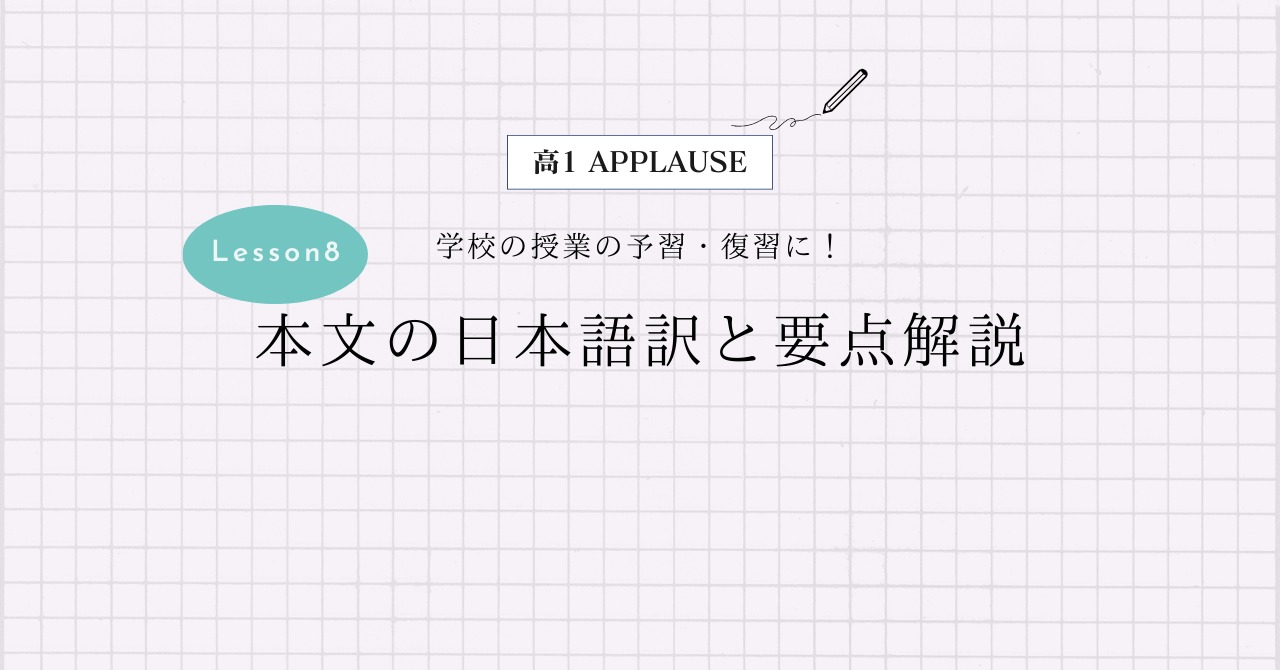開隆堂 高1APPLAUSE Lesson8 Section1の本文の日本語訳と重要箇所の解説です。
Lesson8-2, 8-3, 8-4の解説はこちらからご覧ください。
>高1APPLAUSE Lesson8 Section2 本文和訳
>高1APPLAUSE Lesson8 Section3 本文和訳
>高1APPLAUSE Lesson8 Section4 本文和訳
- APPLAUSE Lesson8 Section1 本文と日本語訳
- APPLAUSE Lesson8 Section1 重要事項の解説
- There are about 8 million 7 hundred thousand living things that exist on earth now.
- Humans are one of them.
- While we are suffering from world population growth, there are lots of different animals that are disappearing.
- The International Union for Conservation of Nature and Natural Resources―IUCN―listed 13,482 kinds of animals as endangered species in 2018.
- Surprisingly, 1,219 mammals out of about 5,500 are listed.
- It means that about 22% of them are becoming extinct, such as Bengal tigers, polar bears, mountain gorillas, and black rhinos.
- When you see these animals at zoos, you might imagine them living in the wild.
- However, some scientists say,
- “In a few years, zoos will be the only places at which you can see these animals.”
- APPLAUSE Lesson8 Section1 まとめ
APPLAUSE Lesson8 Section1 本文と日本語訳
There are about 8 million 7 hundred thousand living things that exist on earth now.
「今地球には約870万の生き物が存在します。」
Humans are one of them.
「人間はその中の1種です。」
While we are suffering from world population growth, there are lots of different animals that are disappearing.
「私たちは世界の人口増加に苦しんでいますが,消えていっている様々な動物がたくさんいます。」
The International Union for Conservation of Nature and Natural Resources―IUCN―listed 13,482 kinds of animals as endangered species in 2018.
「国際自然保護連合(IUCN)は2018年に13,482種の動物を絶滅危惧種として指定されました。」
Surprisingly, 1,219 mammals out of about 5,500 are listed.
「驚くべきことに,約5,500種の哺乳類のうち1,219種が指定されました。」
It means that about 22% of them are becoming extinct, such as Bengal tigers, polar bears, mountain gorillas, and black rhinos.
「そのことは,ベンガルトラ,ホッキョクグマ,マウンテンゴリラ,クロサイなど,哺乳類の約22%が絶滅しつつあることを意味しています。」
When you see these animals at zoos, you might imagine them living in the wild.
「あなたが動物園でこういった動物を見るとき,野生で生活している姿を想像するかもしれません。」
However, some scientists say,
「しかし一部の科学者は言っています。」
“In a few years, zoos will be the only places at which you can see these animals.”
「『数年後,動物園はこういった動物たちを見れる唯一の場所になるだろう』と。」

APPLAUSE Lesson8 Section1 重要事項の解説
There are about 8 million 7 hundred thousand living things that exist on earth now.
ここでは「there構文」が使われていますね。
“about”は「約,およそ」という副詞で,“million”は「100万」,“hundred thousand”は「10万」となります。
“living things”は「生き物」という意味で,“that”が「主格の関係代名詞」です。
“that exist on earth”が先行詞“living things”を修飾していますね。“exist”は「存在する」という動詞になります。
直訳すると「今地球上に存在する生き物が約870万います。」といった感じですね。
Humans are one of them.
“one of 複数名詞”は「名詞のうちの1つ」という表現です。
“them”は“about 8 million 7 hundred thousand living things”を指していますね。
“human”は「人間,人類」という名詞です。
While we are suffering from world population growth, there are lots of different animals that are disappearing.
“while”は「~の間」だけでなく,「~な一方で,~だが」という意味もあります。重要な接続詞なので必ず押さえましょう!
“suffer from~”は「~に苦しむ」という重要表現で,ここでは「現在進行形」になっていますね。
“population”は「人口」,“growth”は「増加,成長」という名詞です。
後半の文は「there構文」になっていて,“lots of~”は「たくさんの~」,“different”は「様々な,異なった」という形容詞になります。
ちなみに“lots of”と“a lot of”の違いは,“lots of”の方がよりくだけた表現というだけで,その他の違いはほとんどありませんよ!
また,“that”は「主格の関係代名詞」で,“that are disappearing”が先行詞“lots of different animals”を修飾していますね。“disappear”は「消える,消滅する」という動詞になります。
ここも「現在進行形」になっていますね。
The International Union for Conservation of Nature and Natural Resources―IUCN―listed 13,482 kinds of animals as endangered species in 2018.
“The International Union for Conservation of Nature and Natural Resources”は「国際自然保護連合」のことです。
「―」は「ダッシュ」といって,直前の語句を補足する働きがあります。「:(コロン)」や「;(セミコロン)」より少しくだけた印象になります。
“list”は「を記載する,リスト化する」といった動詞で,今回は「指定する」と訳しました。
“kind”は「種類」という名詞で,“kind of~”で「~の種類」という重要表現です。
“as”は「~として」という前置詞で,“endangered”は「絶滅の危機にある,危険にさらされた」という形容詞,“species”は「(生物分類の)種」という名詞で,単数形も複数形も同じ形になります。
Surprisingly, 1,219 mammals out of about 5,500 are listed.
“surprisingly”は「驚くべきことに」という副詞です。
“mammal”は「哺乳類」という名詞で,“out of~”は「~の中で,~から外へ」という意味になります。
また,この文は「受動態」になっていますね。
It means that about 22% of them are becoming extinct, such as Bengal tigers, polar bears, mountain gorillas, and black rhinos.
“It”は直前の文全体を指しています。
“mean”は「を意味する」という動詞で,後ろには「接続詞that」が置かれています。
“them”は“mammals”を指し,“of”は前置詞で,”A of B”の形で「BのA」というように後ろから前に訳します。
“become”は「~になる」という動詞で,“extinct”は「絶滅した」という形容詞になります。
ここでは「現在進行形」になっていますが,意味としては「絶滅しつつある」という状態の変化を表します。
“such as~”は「~など,例えば~」という重要表現ですね。
When you see these animals at zoos, you might imagine them living in the wild.
この文では「接続詞when」が使われています。
“these”は“this”の複数形で,「これらは(の)」という意味です。
“might”は「~かもしれない」という助動詞“may”の過去形ですが,今回のように現在形の文でも使うことができます。その場合は“may”よりも可能性の低い推量の意味になります。
“imagine”は「を想像する」という動詞で,”them”は”these animals”を指していますね。
“living”は「現在分詞」で,“living in the wild”が“them”を修飾しています。“in the wild”は「野生で」という意味になります。
However, some scientists say,
“however”は「しかし」という意味の副詞になります。
同じ意味で“but”がありますが,こちらは接続詞なので品詞が異なります。“but”は“文A,but 文B”というように,2つの文を繋ぐ際に使います。
“文A. But 文B.”というように,“but”を文の先頭に置いて1文だけで完結させるのは原則NGとなります。
“In a few years, zoos will be the only places at which you can see these animals.”
“a few”は「少しの,2,3の」という重要表現です。後ろには可算名詞が来ます。
前置詞”in”は,「期間」を示す語と一緒に使うと「~後」という意味になります。よく使うので覚えておきましょう!
“only”は「~しか,だけ」といった強調を示す副詞で,“place”は「場所」という名詞ですね。
“which”は「目的格の関係代名詞」で,“at which you can see these animals”が先行詞“the only places”を修飾していますね。
元々は“Zoos will be the only places.”と“You can see these animals at the places.”という2文です。
そして前置詞“at”の目的語である“the places”を「関係代名詞which」に置き換えて,前置詞“at”とセットで先行詞の後ろに置いたというわけです。
ちなみに前置詞“at”はそのまま残して“the only places which you can see these animals at”としてもOKですし,「目的格の関係代名詞」を省略して“the only places you can see these animals at.”でもOKです。
さらに言うと,2文目の“at the places”は“there”にも置き換えられるので「関係副詞where」を使って,“the only places where you can see these animals”とすることもできますよ。
APPLAUSE Lesson8 Section1 まとめ
以上がAPPLAUSE Lesson8 Section1の日本語訳となります。
「関係代名詞」「分詞」などの文の作り方を確認しておきましょう!
>高1APPLAUSE Lesson8 Section2 本文和訳
>高1APPLAUSE Lesson8 Section3 本文和訳
>高1APPLAUSE Lesson8 Section4 本文和訳
何か分からない点や他に解説してほしい点があれば,お気軽にコメントしてください!




コメント